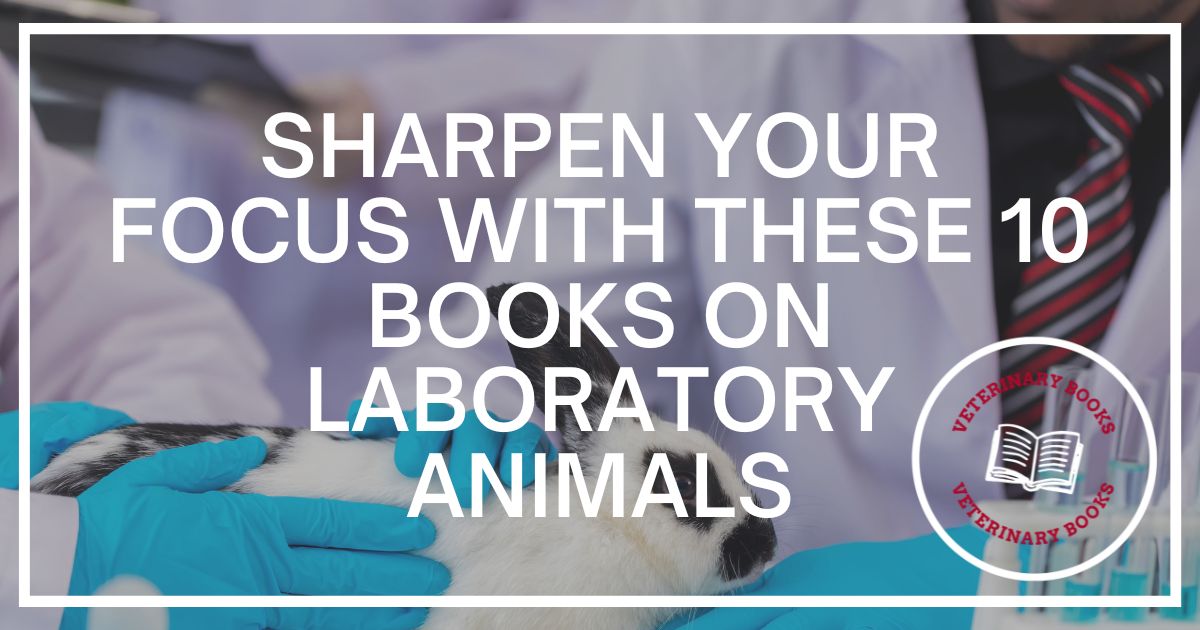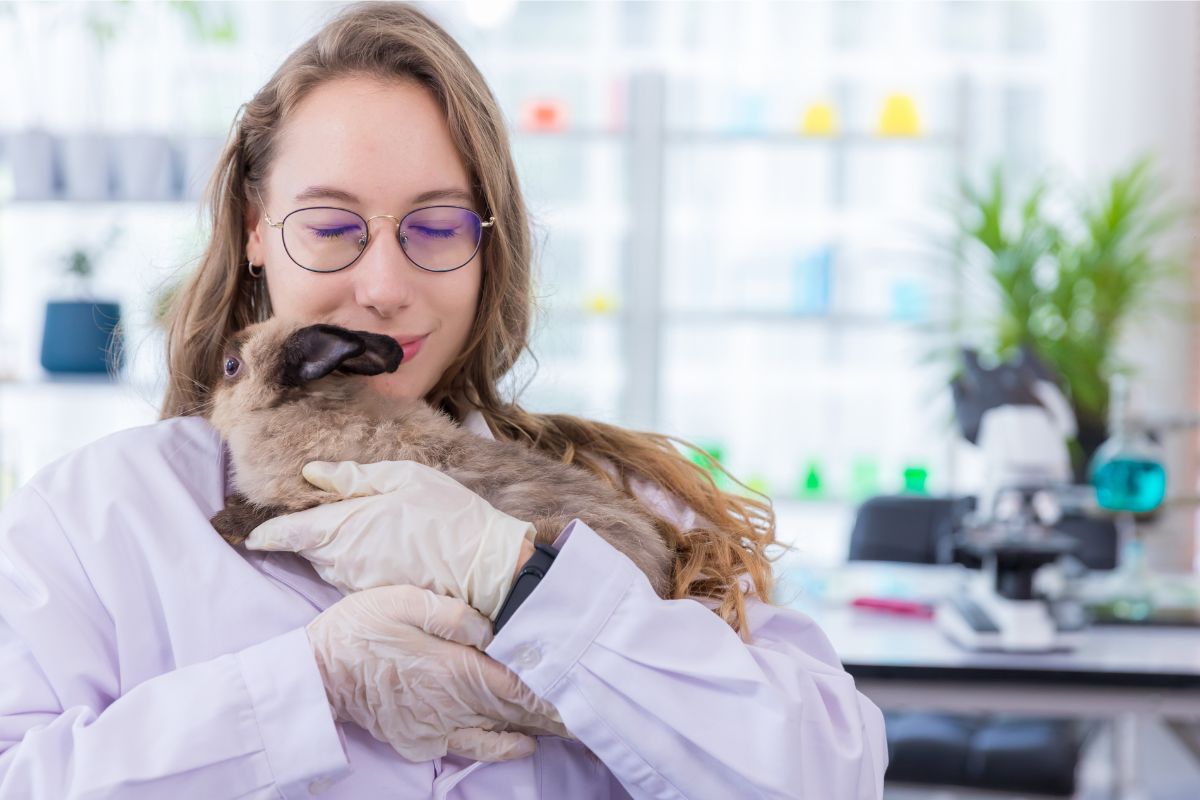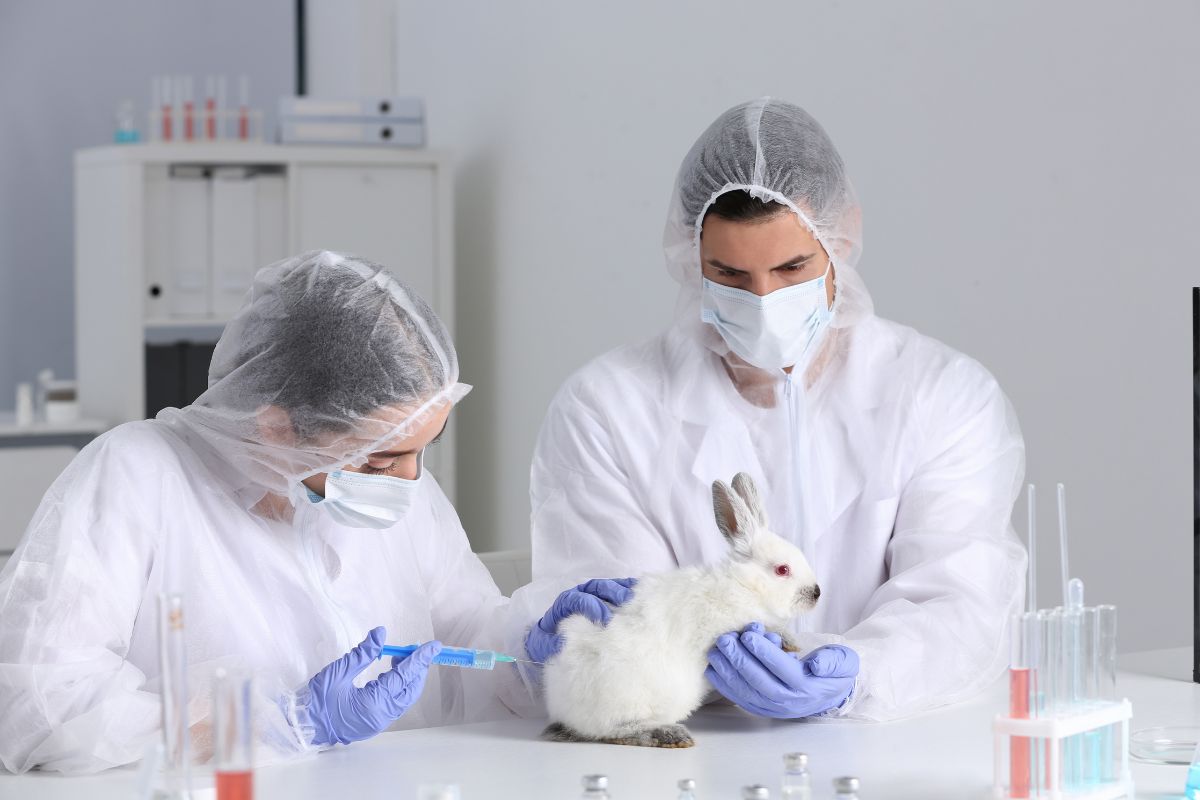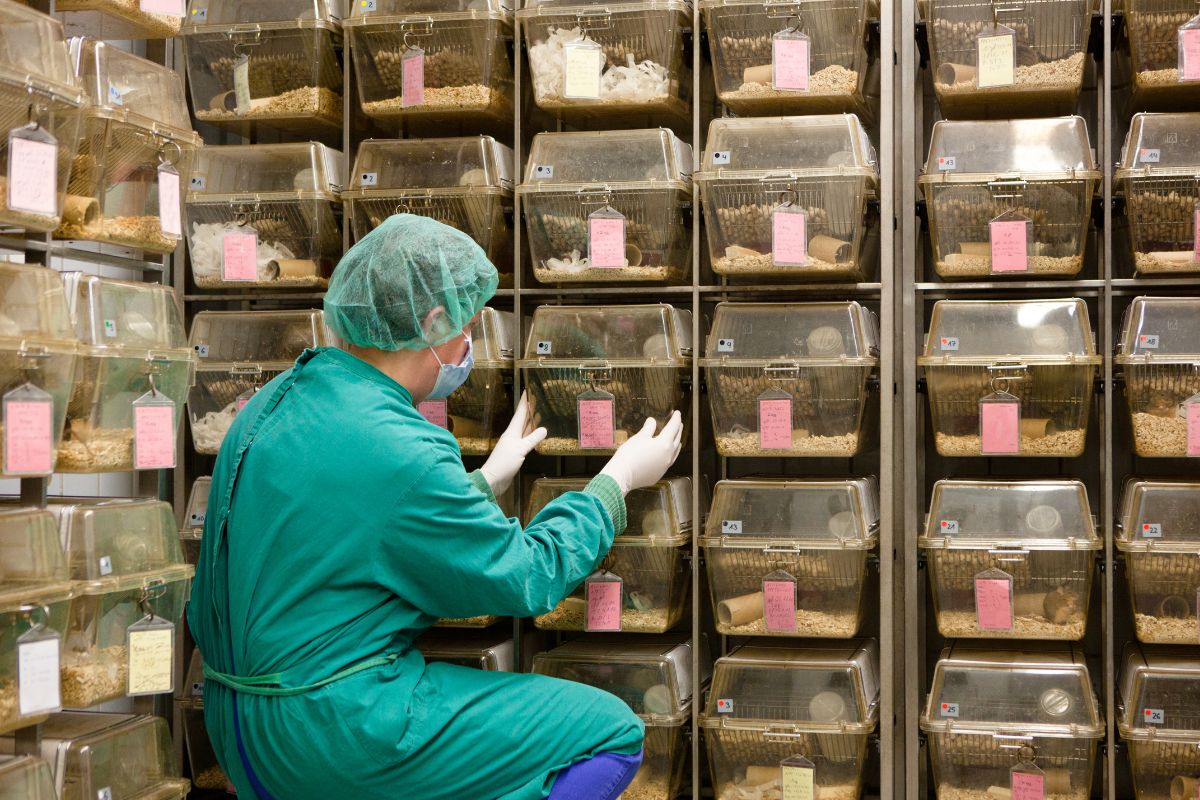Books on Laboratory Animals
Setting up research involving laboratory animals requires lots of responsibility and accountability. Whether you are looking into the general principles of laboratory animal medicine, setting up research facilities, or focusing on a specific species of animals or specific pathological outcomes, we have the books to help you research everything you need.
What is a Laboratory Animal?
Laboratory animals is a term that refers to animals of mammalian, avian, or reptilian species (including those in transport to animal facilities or laboratories), cared for or maintained in animal facilities or laboratories for use in animal experiments and other related activities.
Laboratory animals play a role in various research fields, all covered by the umbrella of the term animal research. Research conducted on animals (wild or captive) includes anything from behavioral, agricultural, and environmental research to clinical trials or teaching.
The welfare of laboratory animals is a subject that does not always get much attention, which presents an issue. Various federal and local laws strictly define research subjects and handling of animals in laboratory settings, and everyone practicing such research must adhere to said regulations and standards.
Understanding the ins and outs of research using live animals is the first step for a researcher in this field. There is an entire branch of veterinary medicine called laboratory animal medicine.
Laboratory animal medicine is a field within veterinary medicine that focuses on diagnosing, treating, and preventing disease in laboratory animals. It also aims to avoid or minimize pain and discomfort in research animals.
The bottom line is that there is no way to do some types of research without using laboratory animals. However, before one embarks upon researching through the use of live animals, lots of crucial thinking and analysis have to be done.
The privilege of doing research using live animals rests upon the premise that such research will yield remarkable and highly impacting scientific results that will significantly improve human and animal well-being.
Our Favorite Books on Laboratory Animals
The best way to prepare for laboratory animal medicine is to read everything you can on the general principles of using animals and go deep into the direction of the specific research you are conducting.
The following list contains 10 of the best laboratory animal books, which cover a diverse range of subject-related matters, from general considerations to the specifics of different specialty research fields.
















Laboratory Animal and Exotic Pet Medicine: Principles and Procedures 2nd Edition
Best General Principles Guide to Laboratory Animal Medicine.
Author: Margi Sirois
Length: 416 pages
This book is a very comprehensive resource for laboratory animal medicine. It covers housing, feeding, diseases, diagnostics, restraints, and therapy of laboratory animals.
It also covers procedures common in laboratory animal research, like collecting blood, administering medicine, and laboratory animal husbandry.
The coverage includes anatomical, physiological, and taxonomical information on different species of animals commonly used for laboratory research. These include rats, mice, guinea pigs, rabbits, hamsters, ferrets, armadillos, birds, frogs, and fish.
Apart from the practical research information about medical procedures and the care of laboratory animals, the book covers ethical and legal information about researching using live animals and an in-depth analysis of pain management and optimal care practices.
The book has an easy-to-follow system, consistently providing the information in each chapter, making it easy for readers to find specific information or compare data on different animals or species.
The book contains high-quality, full-color illustrations and a reader-friendly layout.
Each chapter concludes with questions to help the reader quickly review the chapter’s content.
Readers find this book to be of great value for money and perfect for teaching/studying and practical research purposes.
This book will benefit laboratory research veterinarians the most, although it is also a great resource for veterinary students taking up laboratory medicine subjects.
Everyone looking to learn about the care and housing, medical procedures, and specie of laboratory animals and their specific uses in research will find this book helpful.
This is the second edition of the book.
“Laboratory Animal and Exotic Pet Medicine: Principles and Procedures” is available in paperback and electronic format via Kindle. There are both new and used editions available in paperback.
Compared to other books, this one is a great starting place for new researchers. It encompasses general information on many species and different uses of animals in laboratory medicine and other ways of housing the animals and conducting various medical procedures.
Laboratory Animal and Exotic Pet Medicine: Principles and Procedures 3rd Edition
Best General Principles Guide to Laboratory Animal Medicine
Author: Margi Sirois
Length: 256 pages
The third edition of “Laboratory Animal and Exotic Pet Medicine: Principles and Procedures” book covers more laboratory animal species and has an extended photographs section focusing on the latest technology in laboratory animal medicine research.
A notable expansion of this edition is the inclusion of poultry as a laboratory animal species, with particular attention to the use of backyard chicken which is increasingly popular, and all the accompanying medical procedures, housing principles, and ethical aspects.
The book also includes discussions on each specific animal species used in research to clarify the benefits of using animals for obtaining meaningful research data.
There are also sections called “Technical Notes,” which highlight key points in each chapter and help with the retention of knowledge from the information in the book.
This third edition is available in paperback and Kindle format. The paperback version is available brand new, used, or for rental.
The book will benefit anyone partaking in laboratory animal medicine research or looking to do so soon.
Compared to the second edition, this book offers a lot more information on the latest technologies used in research that uses laboratory animals, provides an insight into the use of backyard poultry in research goals, and a huge collection of new photographs.
Best for Care and Management of Different Laboratory Animals
Author(s): Dorte Bratbo Sørensen.Sylvie Cloutier, Brianna N. Gaskill
Length: 190 pages.
This book focuses on the welfare of laboratory animals used for research purposes. As the title suggests, it offers the approach of building the research strategy around an animal-centric approach that puts the welfare of research animals first.
This book begins by advocating creating conditions that benefit the animals’ emotional, physiological and behavioral needs regarding housing conditions and handling procedures. The goal is to have the animals in a positive state of mind.
The book offers different viewpoints on improving the living conditions for research animals and provides a specific framework through the three R’s (Refinement, Reduction, and Replacement) principle.
The content will benefit both experienced researchers and those just starting in the field through the prism of a different perspective on research animal welfare, looking to shift the standard from exploitation to care for animals.
Readers find this book engaging and useful in establishing a new and better approach to caring for laboratory animals. Most find it brave to consider such a “hot topic” link putting the animals’ before the needs of the experiment,
However, all concur that it is a progressive and logical way of moving forward with laboratory animal medicine.
This book is for researchers, animal caretakers, laboratory animal technicians, facility managers, laboratory research veterinarians, students, and anyone conducting experiments using live animals.
This book will help give you a different perspective on setting up your studies involving live research animals. The principles outlined are going to help you get meaningful and relevant data but, at the same time, provide more than adequate care for the research animals themselves.
This is the 1st edition of this book.
It is available in paperback, hardcover, and Kindle format. New and used versions of the paperback and hardcover varieties are also available.
This book offers a fresh, somewhat polarizing perspective compared to other books. It tackles the research animals’ welfare problem from a different perspective, showing what is, in my opinion, a better overall approach to the care of laboratory animals.
Notes in the Category of C: Reflections on Laboratory Animal Care and Use 1st Edition
Best for Care and Use of Laboratory Animals
Author: Steven M. Niemi
Length: 250 pages.
This book covers improved care for laboratory animals from the perspective of analysis of the current state of the industry, the possible integration of new and emerging approaches, and perspective advances in this field.
The book points out that the welfare of the animals is key to the research, as, without them, there will be no real data to analyze. This laboratory animal care and welfare are critical to the scientific research process.
On top of improved care for research animals, the book looks into the different uses of different animal species, intending to direct you toward the best type of animal for your study. This crucial information aims to prevent the futile and cruel use of non-fitting animals in specific research.
The presentation of the material in the book is well organized and deep, virtually leaving no stone unturned in the quest for the best practices for the care of laboratory animals and their welfare.
Readers find this book informative, easy to read, and thought-inducing, given the author’s fresh perspective on the subject of research animals’ care. Some even go as far as dubbing it extraordinary and a must-read for anyone working in animal research.
This book is great for research veterinarians, students, teachers, federal and non-profit research funding entities, regulatory approval agencies (FDA, EPA), and anyone partaking in live animal laboratory research procedures.
You can acquire this book in paperback or Kindle format. Different paperback options are available, ranging between new and used, provided by other sellers.
This is the first edition of this book.
Compared to other books, and in particular “Animal-centric Care and Management: Enhancing Refinement in Biomedical Research: which tackles the same subject, this book offers a more practical view, focusing on the procedures and principles already in us and ways to improve them rather than implementing brand new ones.
Laboratory Fish in Biomedical Research: Biology, Husbandry and Research Applications for Zebrafish, Medaka, Killifish, Cavefish, Stickleback, Goldfish and Danionella Translucida
Best for Laboratory Animal Medicine Involving Laboratory Fish
Author(s): Livia d’Angelo, Paolo de Girolamo
Length: 474 pages
This book looks into using fish as laboratory animals for scientific research purposes. It is an increasingly popular and fast-growing aspect of laboratory animal medicine.
The book covers different species of fish best suited for laboratory research and the technological and biomedical advantages they offer in various research fields.
From husbandry and maintenance to laboratory fish welfare and experimental protocols, this book offers ways of turning towards freshwater fish species for laboratory research in many different medical fields, both human and veterinary.
Given the specific requirements of fish, this book covers water systems for farming fish in great detail, as well as the optimal ways of managing them.
Some chapters cover breeding fish in laboratory conditions and all assorted challenges that come with it.
An exciting aspect of this book is the potential scientific use of freshwater fish and the experimental protocols which allow them to be a viable candidate for laboratory animal medicine research.
The book focuses on fish species currently used mostly in research, starting with the Zebrafish and covering Medaka, Killifish, Swordtail Fish, Cavefish, Stickleback, Goldfish, and Danella Translucida as well.
This book is perfect for anyone in laboratory animal medicine research, but in particular, those that have access to an infrastructure that can house freshwater fish optimally for conducting specific research.
As usual, students and up-and-coming researchers will find this new perspective on laboratory animal medicine enticing and hopefully take it to another level shortly.
This book will help point you toward laboratory animal research you probably haven’t considered before.
The book is available in paperback and Kindle format. The paperback is available only as brand-new copies.
The Kindle contains all the written and photographic information from the paperback and other video and audio material.
This is the 1st edition of this book.
Compared to other books in this list, this one offers a very interesting and promising perspective by utilizing fish as the main subject in laboratory animal medicine research.
The Zebrafish in Biomedical Research: Biology, Husbandry, Diseases, and Research Applications (American College of Laboratory Animal Medicine) 1st Edition
Best for Biomedical Laboratory Research Featuring Zebrafish
Author(s): Samuel Cartner, Judith S. Eisen, Susan F. Farmer, Karen J. Guillemin, Michael L. Kent, George E. Sanders
Length: 718 pages
This is an extremely comprehensive book on using Zebrafish species for laboratory research. The book covers everything about setting up care and maintenance of zebrafish colonies.
The Zebrafish is an organism that is becoming increasingly popular in live animal research, given its various uses that help researchers gain an insight into human physiology and pathology.
Zebrafish are so popular as laboratory animals because they are a model which helps in the study of disease development and treatment, organ function studies, behavior, cancer, toxicology, and drug discovery. Even though they are fish, they are a suitable model for vertebrate and mammalian research.
Readers find this book to be the authority on the subject of laboratory research on Zebrafish. They find it rather large, a pro in this case, as there is little literature on the subject—a must for those employing Zebrafish in their research.
This book will help research veterinarians, zoologists, ethologists, laboratory technicians, students, and everyone interested in Zebrafish learn everything about caring for them, the procedures involved in laboratory research, and the best research applications for this animal model.
“The Zebrafish in Biomedical Research: Biology, Husbandry, Diseases, and Research Applications (American College of Laboratory Animal Medicine)” is available in hardcover and kindle format. Hardcover copies are available, both new and used, from various sellers.
The book presents a complete overview of Zebrafish biology, husbandry, diseases, and research applications in distinct and well-organized chapters. It features the work of world-renowned authors.
This is the 1st edition of this book.
Compared to other books, this laboratory animal medicine book is specific, focusing only on one species and offering in-depth, comprehensive information on the use of that species in live animal research.
Behavioral Biology of Laboratory Animals 1st Edition
Best Laboratory Animal Medicine Book for the Study of Laboratory Animal Behavior
Author(s): Kristine Coleman, Steven J. Schapiro
Length: 560 pages.
A book that focuses on the behavioral biology of laboratory animals. In over 30 well-organized chapters, the authors outline different species’ behavioral patterns and changes in different environmental settings. The book looks into the behavior of animals bred in captivity for laboratory medicine research.
The premise behind the book is that understanding how laboratory animals behave will help set up the optimal environment and care for them, as well as aid in the research.
The book has three distinct sections, each covering animal behavior in laboratory conditions from a care and welfare standpoint. The first section is an introductory one, followed by a section covering different animal species, before presenting the final section on general animal behavior in captivity.
The book covers fish, amphibians, reptiles, birds, and mammals, making it a comprehensive resource on laboratory animal behavior.
Apart from the studies of animal behavior in laboratory settings, the book also outlines the history of animal behavior in the wild, helping readers better understand behavioral patterns.
Readers find this book to offer great insight and information in understanding and interpreting the behavior of 25 different laboratory animal species. They see the distinction between normal and abnormal behavior to be very helpful in improving the care and welfare of research animals.
The book is for anyone working in maintenance, care, or research programs involving laboratory animals. Apart from being useful for laboratory technicians, research veterinarians, students, and those studying the welfare of laboratory animal species, the book is a great resource for professionals working with these animal species in other environments like zoos, parks, aquaria, etc.
The book is available in hardcover and Kindle format. Hardcover copies are available new and used from various sellers.
This is the 1st edition of this book.
This book focuses on animal welfare, but unlike other books on this list that tackle the same subject, this one approaches it from a behavioral standpoint. Understanding animal behavior in the wild and captivity, going back generations, helps researchers understand laboratory animals and their needs much better.
Pathology of Genetically Engineered and Other Mutant Mice 1st Edition
Best Book for Research Involving Genetically Engineered Mice
Author(s): Peter Vogel, John P. Sundberg, Jerrold M. Ward
Length: 560 pages.
A recent volume that focuses on a subject not many other books in the laboratory animal medicine focuses on. It is a comprehensive resource for pathologists and researchers concentrating on identifying pathological lesions in genetically modified mice.
The sections in this book follow a pattern common in pathology books, with all the information outlined by the body system. There is thorough coverage of pathological findings, including descriptions and photographs.
Some of the conditions covered in this book rarely occur in genetically engineered mice, making this an invaluable resource for those focusing on such research.
Apart from the pathological lesions and findings, the book covers the latest discoveries and technological advances in the pathology of laboratory animal medicine. The book goes back three decades when illustrating how these discoveries came to be.
Chapters in this book include:
An introduction to mouse pathology.
The genetic nomenclature of genetically engineered mice.
Several databases for analyzing these specific subjects.
It also covers necropsy procedures and grading systems for the potential lesions researchers might find.
The book outlines a practical and precise diagnostic system for each organ system in the body.
Lastly, there is a thorough exploration of scientific research concepts that validate animal models, like the Cinderella Effect.
Readers find this book to be instrumental in the field of pathology of genetically modified mice. They find that the organization and delivery of information make this book easy to use and consult and a valuable resource on the field’s most modern methods and approaches.
The book is essential reading material for laboratory research veterinarians, veterinary and medical pathologists, toxicologists, and all scientists using genetically engineered mice in their research.
You can get this book in hardcover and Kindle formats. Hardcover copies are available new, and used.
This is the 1st edition of this book.
“Pathology of Genetically Engineered and Other Mutant Mice” is a book focusing on a specific species in a particular field of laboratory research medicine – pathology. As such, it contains a wealth of information in this direction but does not cover the general principles of research using laboratory animals that some of the other books on this list do.
Planning and Designing Research Animal Facilities (American College of Laboratory Animal Medicine) 1st Edition
Best for Designing Animal Research Facilities
Author(s): Jack Hessler, Noel Lehner
Length: 1500 pages
The largest book on our list, “Planning and Designing Research Animal Facilities,” focuses on the facilities where the research takes place, tackling the animal welfare and care issue from a different standpoint.
It is clear that the research environment directly impacts not just animal welfare but also the behavior of animals. Through epigenetics, their eventual offspring are born in the same setting. That makes the design, expansion, and renovation of animal research facilities a key aspect of laboratory animal medicine.
This book covers a practical approach demonstrating no best practice when building research facilities that house laboratory animals.
Instead of focusing on building research facilities, this book outlines the basic requirements for research facilities and ideas on how to meet those requirements for each specific type of research involving laboratory animals.
The end goal of this book is to encourage people to discover creative and pragmatic ways of optimizing the research facilities that house live animals, improving the quality of their research in the process.
This book is a great choice for research veterinarians, people, and corporations funding laboratory animal research, research institutes, universities, and anyone involved in setting up facilities for housing laboratory animals.
The book is available in hardcover, paperback, and Kindle format. Paperback and hardcover copies are available new and used from various sellers.
This is the 1st edition of this book.
‘Planning and Designing Research Animal Facilities” is unlike any other book on our list, looking towards the facilities and subsequent best practices in the housing and care for research animals, as opposed to the animals themselves.
As such, it offers a fresh perspective on setting up research and perfectly adds to the reading material we previously went over.
Anatomy and Histology of the Laboratory Rat in Toxicology and Biomedical Research 1st Edition
Best for Toxicology and Biomedical Research Involving Laboratory Rats
Author(s): Robert L. Maynard, Noel Downes
Length: 338 pages.
A very specific book covers much information on laboratory rats and their use in biomedical research. The book focuses a lot on toxicology, outlining the detailed anatomy of laboratory rats related to this field.
The book offers detailed dissection methods regarding specific tissues, greatly benefiting those using laboratory rats who do toxicology research.
Classic Miss H. G. Q. Rowett, in combination with modern photographs and micrographs, makes this book stand out over others by adding to its visual value in addition to the informational one.
The organization of chapters is systematic and precise, with many subsequent subchapters making the book very easy to navigate. It outlines the target tissues of toxicological and cancerous agents from an anatomical, histological, and pathological standpoint.
Readers define this book as well-organized and containing wonderful illustrations. Moreover, they find it extremely detailed and helpful in the research of the anatomy and histology of laboratory rats.
The tables, diagrams, and bibliographies at the end of each chapter also caught the eye of many readers.
This book will be of great use to anybody in toxicology, anatomy, pathology, physiology, pharmacology, and zoology. It is also a great reference guide for students and research veterinarians in the field of biomedicine.
The book is available in hardcover and Kindle-friendly e-textbook formats. Hardcover copies are available new, and used.
This is the 1st edition of this book.
Compared to other books, this book focuses on the anatomy of laboratory rats throughout the volume instead of just mentioning it in a chapter or two. The toxicology focus gives this book a different perspective than others in the laboratory mice research field.
Final Words
Laboratory animal medicine is a big research field with many ethical, practical, legal, and technical considerations. Partaking in research involving laboratory animals should follow through with research on the type of animals, variety of facilities, and methodologies and practices that best suit the goal of a specific experiment.
The different books on laboratory animals reviewed above allow potential researchers to set up their work in the best possible way by removing most of the guesswork and ensuring the optimal welfare of the research animals.














